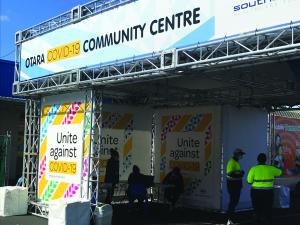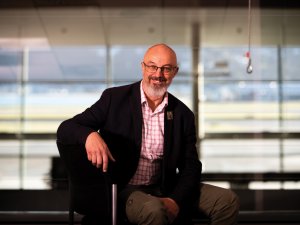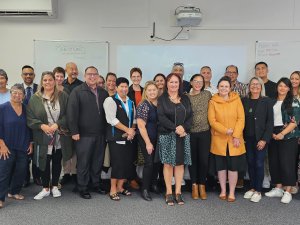Respiratory physician Lutz Beckert considers chronic obstructive pulmonary disease management, including the prevention of COPD, the importance of smoking cessation and pulmonary rehabilitation, and the lifesaving potential of addressing treatable traits. He also discusses the logic of inhaler therapy, moving from single therapy to dual and triple therapy when indicated, as well as other aspects of management
Of warm hearts and frozen wallets
Of warm hearts and frozen wallets
![Wallet [Image: Hamed Taha on Unsplash]](/sites/default/files/styles/cropped_image_16_7_/public/2023-06/hamed-taha-8aWTzz0Vs0Y-unsplash.jpg?itok=g_evij-5)
A classic and disappointing case of local enthusiasm meets central inertia has emerged in south Auckland, writes editor Barbara Fountain
There was no collective gasp at a remarkable build, rather a reminder Te Whatu Ora will call the shots
Locality, locality, locality. It is primary care real estate, in essence, and it is fast acquiring the tropes essential to a gripping episode of build-it-andweep TV show Grand Designs.
We’ve got workforce shortages, project management problems and the ubiqutious baroque dreams on a minimalist budget all pulled together with a passion that refuses to see boundaries.
And so our reporter Alan Perrott went along to a meeting of the country’s largest locality pilot, south Auckland’s Ōtara-Papatoetoe. As we have come to expect of providers working in south Auckland, steeped in their COVID experience of making stuff happen, there was plenty of passion. With a multitude of agencies keenly involved in this locality, good project management is a must.
But before I come to the great reveal, let me take you back to March 2022. It was 12 months after former health minister Andrew Little had presented the Cabinet with his White Paper recommendations for radical reform of the health system. It was the time of the Transition Unit, three months short of the passing of the Pae Ora (Healthy Futures) Bill and the creation of Te Whatu Ora.
Our cover story in March 2022, “Hands up if you can explain localities”, was born out of our own frustration at not having a clear idea of what a locality, first mentioned in Mr Little’s Cabinet paper and cemented in the reform legislations, might look like. By and large, primary care sector representatives felt the same.
The Transition Unit shone some light, clarifying that localities and locality networks, words that tended to merge in discussion, were different in practice. A locality, as the proposed legislation stated clearly, would solely be a geographical area, not a community of shared interest as some had previously speculated.
Locality networks would be groupings of primary and community healthcare providers and social service organisations.
A month later, Mr Little announced the first nine locality pilots. The previous year’s Budget had set aside $45.98 million over four years to develop these pilots and test the locality approach.
Mr Little, in his speech, described a locality as a “set of relationships between government health agencies, providers, the community, iwi and the iwi Māori partnership board”.
Not quite so clear then?
Still, it was stated, Te Whatu Ora’s locality coordinator would pull the threads together to make a locality plan, to be agreed to by the local iwi Māori partnership board and Te Aka Whai Ora, as the basis for commissioning services.
The locality pilots took their respective batons and ran with them.
In the 12 or so months since the first nine locality pilots were named, another two have joined the list, and another 22 are expected before the end of the year.
As recently as early last month, Te Whatu Ora national director, commissioning Abbe Anderson seemed relatively relaxed about deadlines for “draft plans”, happy instead with presentations showing the direction of travel for the localities which she could okay as she visited.
The only concrete deadlines Dr Anderson noted are contained in the legislation – all locality boundaries to be identified by July 2024 and locality plans by July 2025.
Which brings us to the great reveal when the Ōtara-Papatoetoe locality met with Dr Anderson.
Right from the start, the Ōtara-Papatoetoe pilot locality led by South Seas Healthcare’s Silao Vaisola-Sefo has taken Te Whatu Ora at its words – network, collaborate, community, integrate, aspire.
With up to a dozen full partners and another 50 or so in its network, this locality network ranges from legacy agents like PHOs ProCare and the National Hauora Coalition, to community groups such as The Asian Network.
Te Whatu Ora asked; Ōtara-Papatoetoe delivered. It delivered a plan for how all these agencies would work together to provide better health outcomes for people in south Auckland. But there was no collective gasp at a remarkable build, rather a reminder Te Whatu Ora will call the shots and there is no funding.
By the time our reporter Alan attended the locality meeting, a week after the meeting with Dr Anderson, feelings among the locality folk were muted.
I have no doubt that, in taking the opportunity presented by being a locality pilot, the primary care players flung open their COVID playbook and dreamed big. And now they are tired of planning and want to act.
The agency is bogged down in restructuring, in dealing to workforce shortages, not only of front-line clinical staff, but of the managers needed to work with localities, draw up contracts and keep things moving.
And locality network folk are not naive. It’s only a matter of weeks before this Government goes into pre-election slow-mo mode when no key decisions are made. And then there might be a change of government.
In the meantime, primary care waits, the community waits, the patient waits.
We're publishing this article as a FREE READ so it is FREE to read and EASY to share more widely. Please support us and our journalism – subscribe here
One of the benefits of subscribing is you will also be able to share your thoughts about what you read with other in our Comment Stream. You can also take notes on what you read with Capture








![Barbara Fountain, editor of New Zealand Doctor Rata Aotearoa, and Paul Hutchison, GP and senior medical clinician at Tāmaki Health [Image: Simon Maude]](/sites/default/files/styles/thumbnail_cropped_100/public/2025-03/Barbara%20Fountain%2C%20editor%20of%20New%20Zealand%20Doctor%20Rata%20Aotearoa%2C%20and%20Paul%20Hutchison%2C%20GP%20and%20senior%20medical%20clinician%20at%20T%C4%81maki%20Health%20CR%20Simon%20Maude.jpg?itok=-HbQ1EYA)
![Lori Peters, NP and advanced health improvement practitioner at Mahitahi Hauora, and Jasper Nacilla, NP at The Terrace Medical Centre in Wellington [Image: Simon Maude]](/sites/default/files/styles/thumbnail_cropped_100/public/2025-03/2.%20Lori%20Peters%2C%20NP%20and%20advanced%20HIP%20at%20Mahitahi%20Hauora%2C%20and%20Jasper%20Nacilla%2C%20NP%20at%20The%20Terrace%20Medical%20Centre%20in%20Wellington%20CR%20Simon%20Maude.jpg?itok=sUfbsSF1)
![Ministry of Social Development health and disability coordinator Liz Williams, regional health advisors Mary Mojel and Larah Takarangi, and health and disability coordinators Rebecca Staunton and Myint Than Htut [Image: Simon Maude]](/sites/default/files/styles/thumbnail_cropped_100/public/2025-03/3.%20Ministry%20of%20Social%20Development%27s%20Liz%20Williams%2C%20Mary%20Mojel%2C%20Larah%20Takarangi%2C%20Rebecca%20Staunton%20and%20Myint%20Than%20Htut%20CR%20Simon%20Maude.jpg?itok=9ceOujzC)
![Locum GP Helen Fisher, with Te Kuiti Medical Centre NP Bridget Woodney [Image: Simon Maude]](/sites/default/files/styles/thumbnail_cropped_100/public/2025-03/4.%20Locum%20GP%20Helen%20Fisher%2C%20with%20Te%20Kuiti%20Medical%20Centre%20NP%20Bridget%20Woodney%20CR%20Simon%20Maude.jpg?itok=TJeODetm)
![Ruby Faulkner, GPEP2, with David Small, GPEP3 from The Doctors Greenmeadows in Napier [Image: Simon Maude]](/sites/default/files/styles/thumbnail_cropped_100/public/2025-03/5.%20Ruby%20Faulkner%2C%20GPEP2%2C%20with%20David%20Small%2C%20GPEP3%20from%20The%20Doctors%20Greenmeadows%20in%20Napier%20CR%20Simon%20Maude.jpg?itok=B0u4wsIs)
![Rochelle Langton and Libby Thomas, marketing advisors at the Medical Protection Society [Image: Simon Maude]](/sites/default/files/styles/thumbnail_cropped_100/public/2025-03/6.%20Rochelle%20Langton%20and%20Libby%20Thomas%2C%20marketing%20advisors%20at%20the%20Medical%20Protection%20Society%20CR%20Simon%20Maude.jpg?itok=r52_Cf74)
![Specialist GP Lucy Gibberd, medical advisor at MPS, and Zara Bolam, urgent-care specialist at The Nest Health Centre in Inglewood [Image: Simon Maude]](/sites/default/files/styles/thumbnail_cropped_100/public/2025-03/7.%20Specialist%20GP%20Lucy%20Gibberd%2C%20medical%20advisor%20at%20MPS%2C%20and%20Zara%20Bolam%2C%20urgent-care%20specialist%20at%20The%20Nest%20Health%20Centre%20in%20Inglewood%20CR%20Simon%20Maude.jpg?itok=z8eVoBU3)
![Olivia Blackmore and Trudee Sharp, NPs at Gore Health Centre, and Gaylene Hastie, NP at Queenstown Medical Centre [Image: Simon Maude]](/sites/default/files/styles/thumbnail_cropped_100/public/2025-03/8.%20Olivia%20Blackmore%20and%20Trudee%20Sharp%2C%20NPs%20at%20Gore%20Health%20Centre%2C%20and%20Gaylene%20Hastie%2C%20NP%20at%20Queenstown%20Medical%20Centre%20CR%20Simon%20Maude.jpg?itok=Z6u9d0XH)
![Mary Toloa, specialist GP at Porirua and Union Community Health Service in Wellington, Mara Coler, clinical pharmacist at Tū Ora Compass Health, and Bhavna Mistry, specialist GP at Porirua and Union Community Health Service [Image: Simon Maude]](/sites/default/files/styles/thumbnail_cropped_100/public/2025-03/9.%20Mary%20Toloa%2C%20Porirua%20and%20Union%20Community%20Health%20Service%20in%20Wellington%2C%20Mara%20Coler%2C%20T%C5%AB%20Ora%20Compass%20Health%2C%20and%20Bhavna%20Mistry%2C%20PUCHS%20CR%20Simon%20Maude.jpg?itok=kpChr0cc)